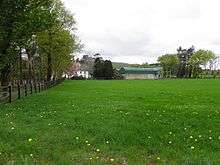Gortaree
Gortaree is a townland in the Civil Parish of Tomregan, Barony of Knockninny, County Fermanagh, Northern Ireland.

Etymology
The townland name is an anglicisation of the Gaelic placename “Gort a Righ” which means ‘The Field of the King’. The oldest surviving mention of the name is in a grant dated 14 October 1612 where it is spelled ‘Gortoerie’. Spellings in later grants and depositions include Gortery (1620), Gartharee (1643) and Gortery (1659).[1]
Geography
It is bounded on the north by Aghyoule and Aghintra townlands, on the east by Aghindisert & Derrintony townlands, on the south by Ummera and Knockateggal townlands and on the west by Gortahurk & Tonymore townlands. Its chief geographical features are Slieve Rushen mountain on whose eastern foothills it lies reaching to an altitude of 360 feet above sea-level and some mountain streams.
The townland is traversed by the Ballyconnell Road, the Teemore Road and some minor lanes.
Gortaree covers an area of 280 statute acres.
History
The townland formed part of the ballybethagh of Calvagh in medieval times. At the beginning of the 17th century it was owned jointly by Bryan McPhilip O’Reyly and Edward Rutlidge but was confiscated by the Crown in the 1609 Ulster Plantation and it formed part of the half-territory of Aughrin which was granted to Sir Hugh Culme in 1610. Culme later relinquished his claim to the Crown, perhaps because there was confusion at the time as to whether the townland formed part of County Fermanagh or County Cavan. By an order of the Lord Deputy dated 14 October 1612 the townland was granted, inter alia, to Lady Margaret O’Neill, the widow of Sir Hugh Maguire deceased. In 1641 and also in 1670 it was owned by Sir William Balfour.[2] In the 1641 Rebellion John McCorry of Gortaree was listed as one of the Irish rebels so he must have been a tenant of Balfour's.[3]
The Tithe Applotment Books for 1827 list the following tithepayers in the townland- Quinn, Drum, Rooney, Burke, Graves, McGauran, Clarke, McGuire, Wallace.[4]
The population of the townland in the 1841 census was 124.
Griffith's Valuation of 1857 lists twenty-four occupiers in the townland.[5]
In the 1901 census of Ireland, there are twenty-two families listed in the townland.[6]
In the 1911 census of Ireland, there are nineteen families listed in the townland.[7]
Antiquities
The only historic site in the townland is Gorteen House.
References
- ↑ http://www.placenamesni.org/historicforms.php?getPnameId=13801
- ↑ Settlement on a Plantation Estate, the Balfour Rentals of 1632 and 1636 by John Johnston, in Clogher Record Vol. 12, No. 1 (1985), pp. 92-109
- ↑
- ↑ Tithe Applotment Books 1827
- ↑ GortareeGriffith’s Valuation 1857
- ↑ Census of Ireland 1901
- ↑ Census of Ireland 1911